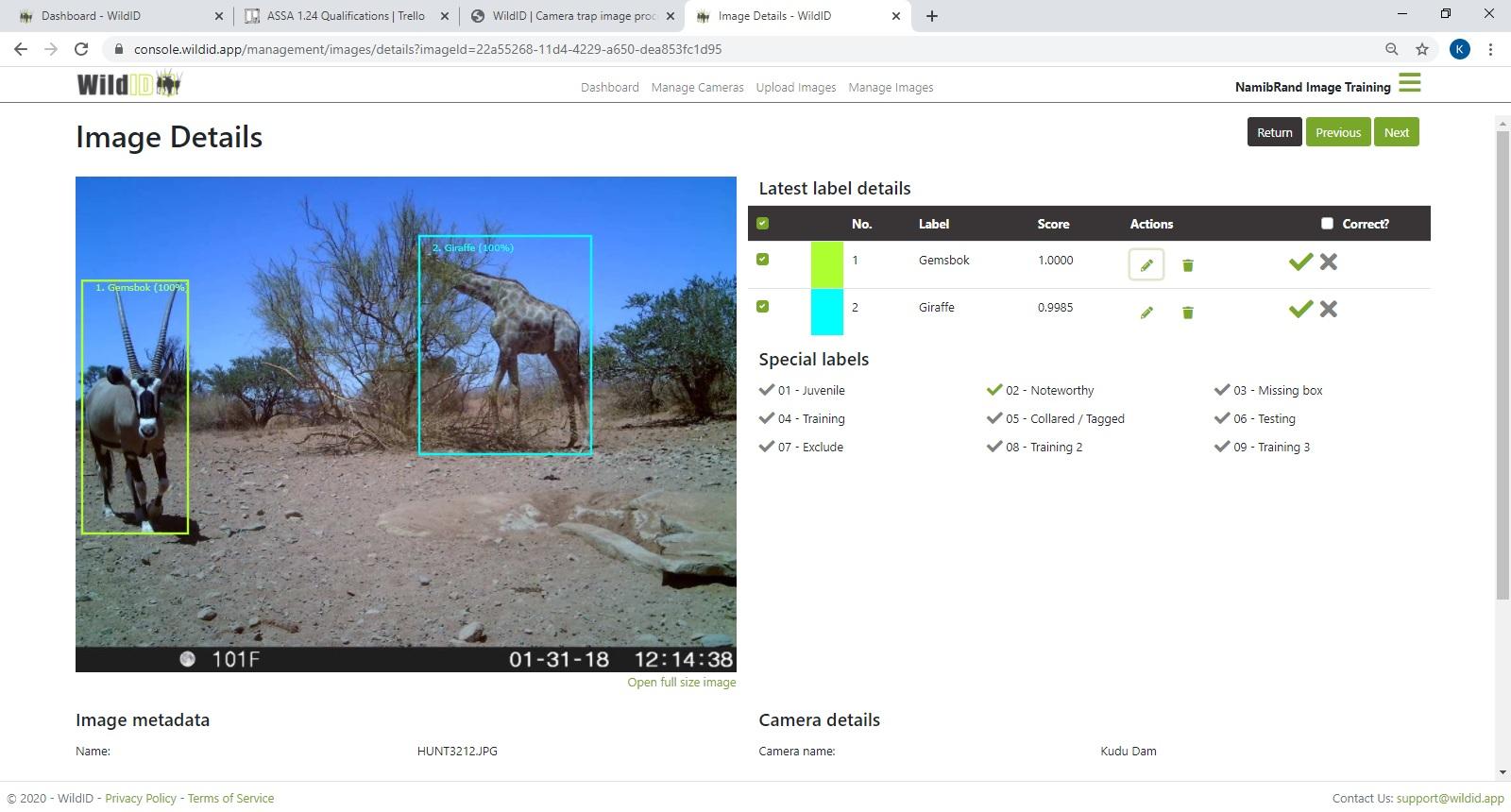About WildID
WildID is an easy-to-use online application to process image data from camera traps. After users upload their camera trap images, WildID automatically detects (places bounding boxes) and then identifies animals in the images, handling multiple individuals and species within each image.
You can then:
- view, search and filter images,
- make changes to species labels or add special tags to images, and
- export data for reporting.
One of NamibRand Nature Reserve's collared gemsbok seen in a screenshot from WildID. WildID did the detection and recognition of the animals automatically, the "collared" tag was added manually by a user. @WILDLABSNET #Tech4Wildlife #NamibRand pic.twitter.com/uGcTdNW5L1
— WildID (@WildIDApp) February 25, 2021
WildID is focused on Southern African species, of which we currently recognise 61 (including humans), plus empty images. A list of the species currently identified can be found here.
To achieve the detection and recognition we have trained a machine learning model, using camera trap data from a reserve in Namibia that we are collaborating with, as well as publicly available data via the Snapshot Safari project (Serengeti and Enonkishu, and 5 SANParks reserves, Camdeboo, Kgalagadi, Kruger, Karoo and Mountain Zebra). As more users come on board and we have examples of more cameras (models and trap sites) and species, we will retrain the model about every three months, so that the accuracy improves over time, gets more targeted for your cameras and sites, and we can add more species as necessary. We are also actively adding new features to the software, and invite users to let us know what would be of most use.

Nick van Doormaal, a Wildlife Crime Analyst with Transfrontier Africa NPC near Hoedspruit, South Africa, says:
"Transfrontier Africa found out about WildID thanks to Craig Spencer, the director and founder of our non-profit organization. We use the WildID platform to get through our backlog of camera trap data. So far, our experience has been great with accurate classifications, and the customer support was really helpful to get things started. The platform is user-friendly and intuitive. In the beginning there was no user manual available, but even without it I could still make it work. Now with the user manual, it is even easier".
Rather brave zebra they have at #namibrand ?
— WildID (@WildIDApp) March 5, 2021
Use WildID to unlock images from your #cameratraps that have been gathering dust in harddrives for years. pic.twitter.com/IWGOJiPwsU
WildID was born out of a suggestion by NamibRand Nature Reserve in Namibia. Murray Tindall, the Warden of NamibRand, says:
“We get up to 10 000 images per month from each of our camera traps, and we simply didn’t have the time to process the data. I used to scan through each batch of images manually and just pull out the predators I spotted to report on that in a manual spreadsheet. Years’ worth of photographs were sitting in storage waiting for the day when we might be able to extract something meaningful from them. We looked at some image classification software, but being in the desert with very barren landscapes we were getting back results like polar bear, presumably because the sand looked like snow to the software. We thought there was a gap for software focussed on Southern Africa. Now we’re just waiting for WildID to be able to pull the numbers on the tags on our vultures out of the images for us!”
You can register for a free online trial of WildID at https://console.wildid.app/identity/account/register
There is a comprehensive User Guide at https://userguide.wildid.app/
Get support and ask questions at [email protected]
Follow WildID on Twitter for news about model updates.
Tech Facts about WildID

- We started off using Sara Beery’s Context R-CNN (thank you Sara and co!). We used this model within WildID on images from NamibRand to create bounding boxes and do initial species recognition. We then corrected the identifications, especially for unknown species, using the WildID UI. We could then export labelled data to train our own series of models.
- To create our models we used the TensorFlow Object Detection API. Our training pipeline uses Google Dataflow for preparing the data and the Google AI Platform with GPU support to do the actual training.
- We have also extracted data from the Snapshot Safari datasets on LILA BC (more thanks). We use a Google Colab to retrieve and massage the data from the Snapshot Serengeti dataset into WildID. After WildID has localised objects in the images we use another Google Colab to update initial classifications from the Snapshot Safari metadata.
- We have a good pipeline set up for exporting new curated test and training data from WildID to TensorFlow for future iterations.
- Our latest model is hosted in a TensorFlow Serving container on a dedicated physical server where we are getting good inference speeds even without a GPU. The model is exposed with our own Object Detection API written in Python.
- The WildID web application is hosted in Microsoft Azure and submits images to our Object Detection API for detections. The images are securely stored using Azure Cloud Storage and the data is maintained in a Azure SQL Server.
About Alchemy Software
https://www.alchemysoftware.co.za/
Alchemy Software is a small, friendly software development company based in Cape Town, South Africa. After close to 20 years of custom development on a wide range of business applications and products, we are now looking to move more exclusively into the conservation space, to which end we have developed WildID.
Try WildID Now!
Begin your free trial here on WildID to start processing your camera trap data.


Add the first post in this thread.